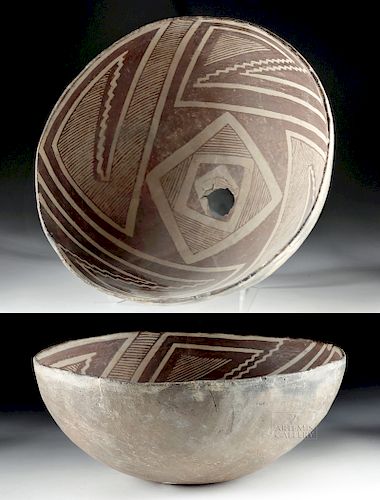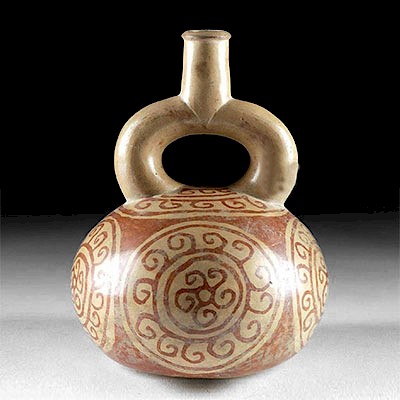Rare Mimbres Bowl with Fish, "Kill" Hole
Lot 97
About Seller
Artemis Fine Arts
686 S Taylor Ave, Ste 106
Louisville, CO 80027
United States
Selling antiquities, ancient and ethnographic art online since 1993, Artemis Gallery specializes in Classical Antiquities (Egyptian, Greek, Roman, Near Eastern), Asian, Pre-Columbian, African / Tribal / Oceanographic art. Our extensive inventory includes pottery, stone, metal, wood, glass and textil...Read more
Categories
Estimate:
$2,500 - $3,500
Absentee vs Live bid
Two ways to bid:
- Leave a max absentee bid and the platform will bid on your behalf up to your maximum bid during the live auction.
- Bid live during the auction and your bids will be submitted real-time to the auctioneer.
Bid Increments
| Price | Bid Increment |
|---|---|
| $0 | $25 |
| $300 | $50 |
| $1,000 | $100 |
| $2,000 | $250 |
| $5,000 | $500 |
| $10,000 | $1,000 |
| $20,000 | $2,500 |
| $50,000 | $5,000 |
| $100,000 | $10,000 |
| $200,000 | $20,000 |
About Auction
By Artemis Fine Arts
Jan 24, 2019
Set Reminder
2019-01-24 10:00:00
2019-01-24 10:00:00
America/New_York
Bidsquare
Bidsquare : Pre-Columbian / Ethnographic Art
https://www.bidsquare.com/auctions/artemis-gallery/pre-columbian-ethnographic-art-3814
Featuring ancient and ethnographic art from around the world, including Pre-Columbian, Native American, African / Tribal, Ethnographic, Spanish Colonial, Fossils, Fine Art, much more. Artemis Fine Arts info@artemisfinearts.com
Featuring ancient and ethnographic art from around the world, including Pre-Columbian, Native American, African / Tribal, Ethnographic, Spanish Colonial, Fossils, Fine Art, much more. Artemis Fine Arts info@artemisfinearts.com
- Lot Description
Southwestern US, Mimbres Valley, New Mexico, ca. 950 to 1150 CE. A classic bowl from an imaginative and unique ceramic culture. The bowl has step walls, an unpainted exterior, and a dramatic series of abstract geometric motifs on its interior. Painted in tondo is a single fish, a stylized depiction with a triangular tail and rounded body. Part of the fish is obscured by a "kill" hole, which researchers believe means that the bowl was ritually punctured at its nadir prior to interment with a human burial. The fish is surrounded by a series of diamonds, tight lines, and squares, before the motifs widen out into stepped triangles and long diagonal shapes whose forms may have been inspired by the dramatic geology of the Mimbres homeland. Size: 10.4" W x 4.45" H (26.4 cm x 11.3 cm)
Fascinatingly, a variety of fish are depicted on Classic Mimbres pottery, as well as fishing scenes. A 1986 study by Jett and Moyle identified 20 fish taxa on Mimbres bowls, 18 of which are marine, from the Gulf of California. Does this mean that Mimbres traders traveled nearly 1000 miles across the desert to gain access to the rich resources of the coast? It must have been an arduous and remarkable journey. On this vessel, the fish is probably a marker of a particular clan, lineage, or other social group - perhaps one that included these adventurous individuals.
c. f. Jett and Moyle, 1986, "The Exotic Origins of Fishes Depicted on Prehistoric Mimbres Pottery from New Mexico", American Antiquity, vol. 51, issue 4, pgs. 688-720.
Provenance: ex-private Santa Fe, New Mexico, USA collection
All items legal to buy/sell under U.S. Statute covering cultural patrimony Code 2600, CHAPTER 14, and are guaranteed to be as described or your money back.
A Certificate of Authenticity will accompany all winning bids.
We ship worldwide and handle all shipping in-house for your convenience.
#142913Repaired from two or three large pieces, with small repairs around the "hill hole". These repairs are excellently done and nearly invisible, with no added pigment. Small chips and losses to pigment commensurate with age. Old collection information written on one side of exterior, now very faded.Condition
- Shipping Info
-
All shipping is handled in-house for your convenience. Your invoice from Artemis Gallery will include shipping calculation instructions. If in doubt, please inquire BEFORE bidding for estimated shipping costs for individual items.
-
- Buyer's Premium



 EUR
EUR CAD
CAD AUD
AUD GBP
GBP MXN
MXN HKD
HKD CNY
CNY MYR
MYR SEK
SEK SGD
SGD CHF
CHF THB
THB

















